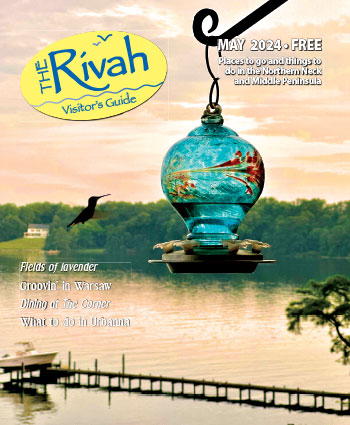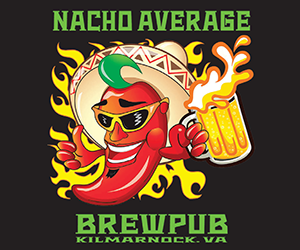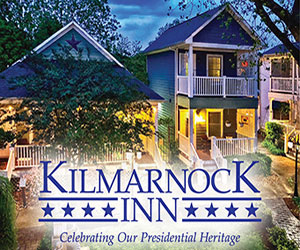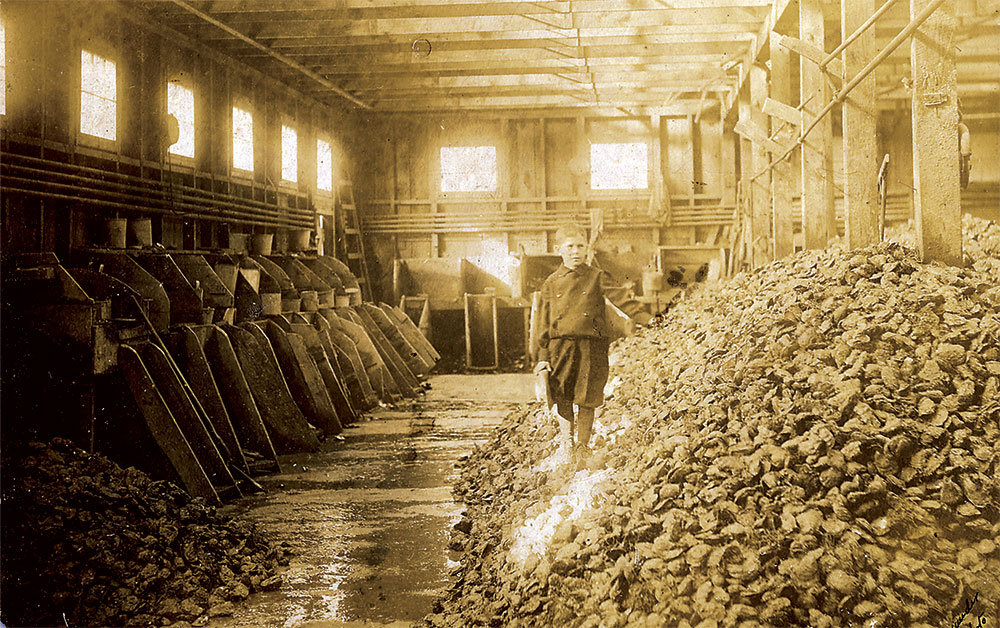
by Larry Chowning –
During colonial Virginia’s 1640s real estate land rush, the first official English settlers arrived in Lancaster County and, what would become Middlesex County, armed with markers, pads and broad axes to record and mark their land grant property lines.
They paddled and poled along creeks and coves looking for prime real estate for the building of a home and good land to grow tobacco. A signature of attractive waterfront property then was when there were mounds of oyster shells jutting out of the water near the shore.
For generations, Native Americans roasted oysters for sustenance and disposed of shells by tossing them onto mounded shell piles in the water. As an afterthought, settlers were looking for waterfront property where oysters flourished close to shore; but their main search was for land already cleared by Native Americans for agriculture. The mounded in-water oyster piles were a sign the land had been used as a village or home of Native Americans. The elimination of the laborious task of removing trees and forest to grow tobacco was an attractive feature of property to those early setters.
Once settlers established their boundaries, built their homes and started living there, the oyster became a vital part in the lives of Tidewater Virginians. The bivalve provided a nature grown food source for colonists a short walk from their homes and the oyster would later go on to become an economic force in the area’s economy.
Northern oystermen
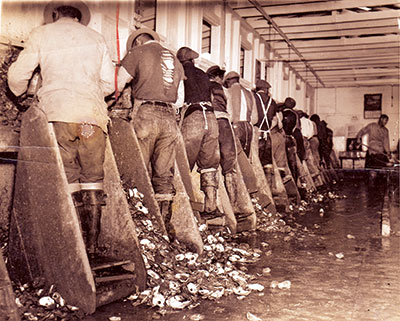
Through the late 1600s and well into the 1700s, Virginia developed a cottage industry around oysters. As the population moved inland resulting in some Virginians having less access to the water and oysters, a cottage industry evolved. Oystermen tonged oysters and sold oysters-in-the-shell to neighbors and friends not so inclined or able to go out and harvest their own.
The market expanded as the customer base grew with people wanting shucked raw meat all ready to drop into a frying pan or an oyster stew pot. To meet that demand, oystermen built small buildings onto their property where they would shuck oysters out of the weather and where customers could come to buy.
As demand for oysters grew beyond the neighborhoods, oystermen hired other oystermen as shuckers and expanded the size of their oyster houses to increase production.
This cottage industry was already well established when in the late 1700s New York, New Jersey and Connecticut oyster boats arrived on the Chesapeake to bag, borrow and steal oysters to meet an enormous supply and demand in New York City and elsewhere in the north.
By then, Northern oyster growers had long ago passed the cottage industry stage and the large population in the north had depleted oysters on natural beds in their rivers and were unable to privately grow oysters fast enough to meet demand.
The Yanks introduced Chesapeake Bay oystermen to the national market scene and within a decade or two large oyster shucking houses in Virginia and Maryland were built on the bay to meet increasing national demand for shucked Chesapeake Bay oysters.
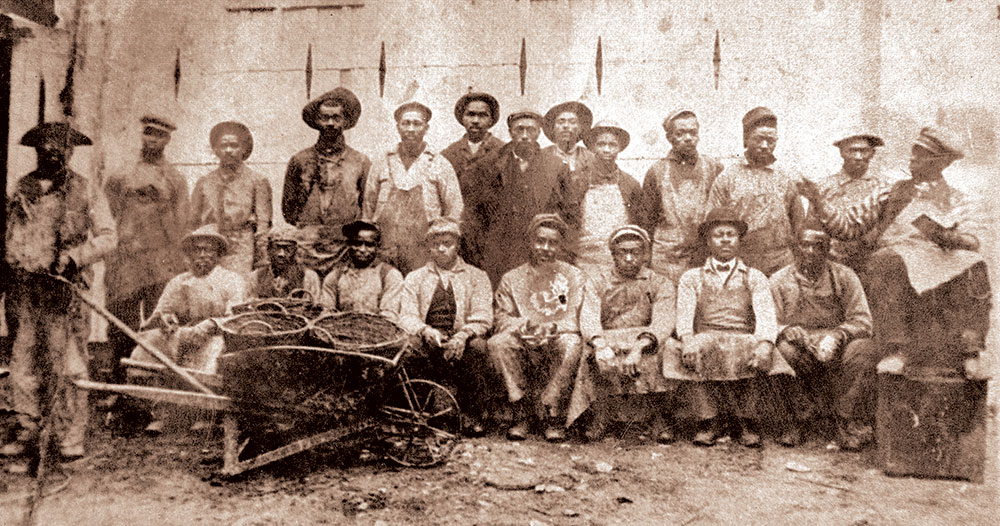
J.W. Hurley & Son Seafood
In waterfront towns and steamboat landings, particularly those on the Rappahannock River where superb market size oysters grow, shucking houses and sometimes more than one sprang up. Small two- and three-man shucking houses were scattered on most every creek and stream up to freshet lines in the rivers where oysters stop growing.
The industry started well before the Civil War but in the aftermath of the war oysters provided sustenance and a major boost to the local economy. While many areas in Virginia suffered the economic depression associated with the South losing the war, the oyster industry helped Tidewater Virginia rebound economically.
The Town of Urbanna had one of the largest oyster shucking houses in the region in J.W. Hurley & Son Seafood. Hurley was from Hurlock, Md. He discovered Urbanna and the Rappahannock River while buying oysters for an Eastern Shore of Maryland oyster company. He liked the area, moved here and established a shucking house and seafood business at the foot of Virginia Street in town. His brand “King of Them All Famous Rappahannock River Oysters” became known nationwide.
During the oyster season, African-American shuckers came to Urbanna from surrounding counties to work at Hurley’s and at other shucking houses. Hurley’s employed between 50 to 100 shuckers hired to shuck between 300 and 400 bushels of “shucking stock” daily. To accommodate housing for shuckers, a boarding facility called the “Long House” was built on the shoreline. African-Americans lived in the Long House and worked six days a week.
In a 1985 Southside Sentinel interview with a Hurley employee, the late Woodland Rowe of Urbanna spoke of a day in the life at the shucking house. “When I came to Hurley’s (in the late 1920s) there were about 50 to 60 shuckers working, but I was told that in the early days (1890s) there were as many as a hundred shuckers. Most of them were Black males, but later on we had more Black female shuckers. I remember the sounds of the shuckers. They would hum and sing as they worked. Some of them could really sing too, boy.
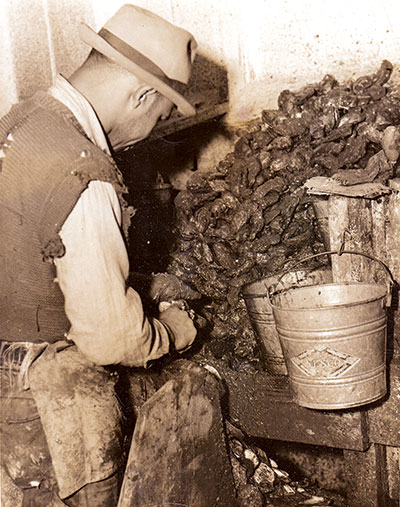
“They would start work around 6 a.m. and leave at 5 p.m. During breakfast and lunch, they gathered around the potbellied wood stove, ate sandwiches and canned sardines and told jokes to one another. They shucked oysters into a bucket. When full, the bucket was emptied and a tally was kept of each full bucket from each individual shucker. The shucked oysters were taken to a skimming room where the raw meat was cleaned of shell and grit, and measured to determine the shuckers wages. Shuckers were paid piecemeal by the number of gallons they shucked in a day. While I was there shuckers were paid between 30 and 35 cents a gallon. Oysters were packaged for market in five-, 10- and 15-gallon containers sealed and covered with ice,” he said.
“Part of my job was to be the maintenance man. In those days, shuckers worked in wooden shucking stalls (called boxes by some), and I made every one of them. We had standard size stalls, but I even made custom stalls. When Mason Carter got old, Mr. Hurley told me to make him a box (stall) he could step into and a board fit across it for a seat.”
There were also day men, or shell wheelers, hired to clean up and keep shuckers in oysters. “They were hired and paid by the hour. Oysters were handled in bushel oak-splint or wicker baskets. Later, Boyd Hurley got wire baskets. I was told oak-splint bushel baskets were brought here by Yankee oystermen,” said Rowe. “The wicker baskets were purchased from Baltimore and delivered by steamboat at Burton’s (steamboat) Wharf.”
The Hurleys sold most of their oysters to O.E. Wentworth Co. in Baltimore. Hurley oysters were shipped to Baltimore six days a week by steamboat. On Monday, Tuesday, Thursday and Friday they were shipped from Burton’s (steamboat) Wharf at the foot of Watling Street in Urbanna.
On Wednesdays, Rowe trucked iced-down oysters to West Urbanna (steamboat) Wharf at the end of Lord Mott Road. “Wednesday was the only day the side-wheeler (steamboat) Middlesex came in the river,” said Rowe. “It always went to West Urbanna Wharf because it was too big to turn around in Urbanna Creek.” On other days, the smaller (prop driven) steamers came into the creek landings to pick up Hurley’s product.
“Steamboats did not run on the Rappahannock on Saturdays, so I hauled oysters to West Point on the York River in a snub-nose International truck to catch the steamboat there bound for Baltimore. Sometimes I’d be a half-day driving to West Point. There weren’t many good roads back then,” said Rowe.
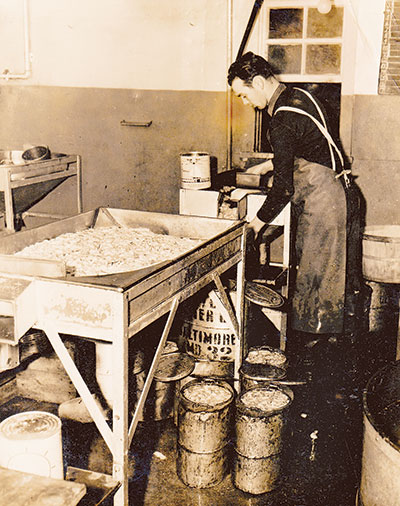
Selling shells
Hurley also sold his oyster shells to lime manufacturing companies and one buyer was the well-known Captain Harvey H. Conway from Cambridge, Md. Conway was patriarch of the Conway family sailing fleet. Many of the vessels in the fleet were named after Conway family members. “They say he started out with a few dollars in a sugar bag and sailed his way to be a millionaire,” said Rowe.
“Mr. Hurley and Captain Harvey had known each other from when they were young and whenever he would show up to buy shells, Mr. Hurley got me to drive him around to see if he could purchase shells from other oyster houses,” said Rowe.
“One day when I was driving him around he told me this story. ‘During a weeklong blinding snowstorm in the early 1930s, one of his sailing schooners, loaded down with oysters and bound for Baltimore was stranded in the Patuxent River.
“Captain Harvey’s son, Harvey Jr., was captain and he was anchored on the river waiting for the snow to stop. Captain Harvey was not happy with his son. ‘You don’t make money when the boat sits still,’ he had told his son many times. So, Captain Harvey took another boat from Cambridge and sailed in that blinding storm across the Bay to the Patuxent and told his son to get off the boat. The old skipper and a mate sailed the loaded vessel into Baltimore Harbor.”
When Captain Harvey came up to the dock, several men on the pier were surprised to see a vessel coming in the harbor during the blizzard. One of the men asked him, ‘Captain Harvey, you surely couldn’t see much out there. Weren’t you worried about running her up onto a sandbar?'”
“Captain Harvey replied, ‘When you’ve run into every sandbar on Chesapeake Bay you know where they all are,'” said Rowe.
When steamboats were running, every community located near a wharf on both sides of the Rappahannock River had an oyster shucking house nearby. The business continued to be an important part of the area’s economy until the 1980s, when oyster diseases, MSX and dermo, killed thousands of oysters up and down the Rappahannock River and beyond.
Virginia’s recent oyster revival is more closely tied to aquaculture driven sales of single half-shell oysters to restaurants than to the pint- and quart-jar shucked oyster market. However, there are several small oyster houses still shucking oysters in the area, but the days of oyster houses supporting 50 to 100 shuckers has passed.
 Some rare antique oyster cans are worth thousands of dollars
Some rare antique oyster cans are worth thousands of dollars
Until the 19th century, oysters were a coastal delicacy, because lack of refrigeration and the short shelf-life of the meat could not sustain long overland travel.
That changed when railroads and canning, and a food-preservation canning breakthrough made in France in 1812, made oysters less perishable and able to be transported long distances.
The canning process contributed to millions of oysters being shucked, steamed, and hermetically sealed in pint and gallon cans. Shucking plants sprang up throughout Virginia and Maryland, and the individual oyster houses had their own style cans with their own logo and brand.
Packing houses had strong competition from hundreds of competing oyster houses on the bay so part of their marketing strategy was to create a unique and colorful oyster can to attract customers.
Cans are no longer used in the oyster industry, so antique oyster cans have become collector items and collectors often pay thousands of dollars for rare cans.
Books have been written on oyster cans to aid collectors and those interested in cans to identify value and history of cans. Museums in the bay regions feature collections of cans to encourage visitors to come see and learn more about Chesapeake Bay’s oyster heritage.


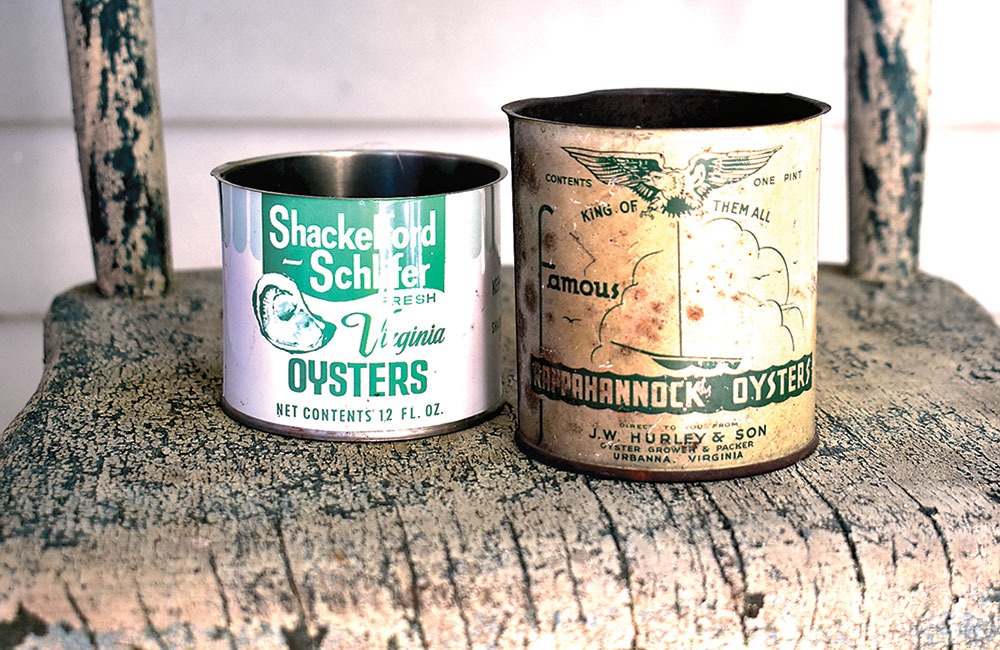 Some rare antique oyster cans are worth thousands of dollars
Some rare antique oyster cans are worth thousands of dollars